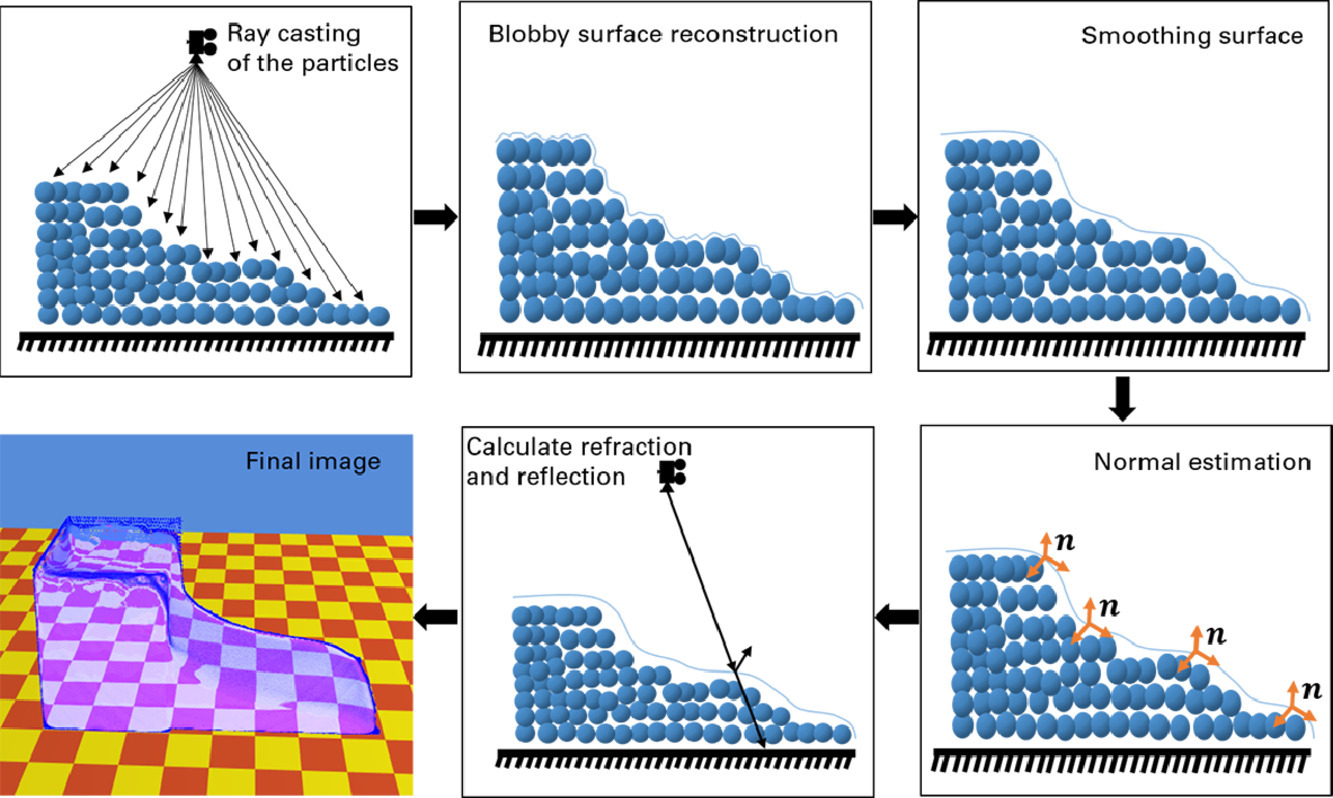I am a PhD Candidate at LIGUM (University of Montreal) and Voxar Labs (Center of Informatics at Federal University of Pernambuco (UFPE)) (joint PhD) under the supervision of Dr. Pierre Poulin and Dr. Veronica Teichrieb.
I received my Master and Bachelor in computer science from UFPE. In the masters, I worked with fluid simulation using Smoothed Particle Hydrodynamics and particle-based rendering for fluid simulation. During my graduation I participated of the Science Without Borders program being able to study one year at Swansea Univerity and did my summer project under the supervision of Dr. Mark Jones and Dr. Chenfeng Li entitled SPH for Visual Applications.
I was an intern at Disney Research in Los Angeles under the coordination of Dr. Kenny Mitchel and have participated in research and development projects at Voxar Labs with Samsung, SimplifiqueGP, HP, and LG.
My main research interest is realistic real time rendering using global illumination methods.

Volumetric representations allow filtering of mesh-based complex 3D scenes to control both the efficiency and quality of rendering. Unfortunately, directional variations in the visual appearance of a volume still hinder its adoption by the real-time rendering community. To alleviate this problem, we propose two simple structures: (1) a virtual mesh to encode the directional distribution of colors and normals, and (2) a low-resolution subgrid of opacities to encode directional visibility. We precompute these structures from a mesh-based scene into a regular voxelization. During display, we use simple rendering methods on the two structures to compute the image contribution of the appearance of a visible voxel, optimizing for efficiency and/or quality. The improved visual results compared to previous work are a step forward to the integration of volumetric representations in real-time rendering.

Preparing datasets for use in the training of real-time face tracking algorithms for HMDs is costly. Manually annotated facial landmarks are accessible for regular photography datasets, but introspectively mounted cameras for VR face tracking have incompatible requirements with these existing datasets. Such requirements include operating ergonomically at close range with wide angle lenses, low-latency short exposures, and near infrared sensors. In order to train a suitable face solver without the costs of producing new training data, we automatically repurpose an existing landmark dataset to these specialist HMD camera intrinsics with a radial warp reprojection. Our method separates training into local regions of the source photos, \ie mouth and eyes for more accurate local correspondence to the mounted camera locations underneath and inside the fully functioning HMD. We combine per-camera solved landmarks to yield a live animated avatar driven from the user’s face expressions. Critical robustness is achieved with measures for mouth region segmentation, blink detection and pupil tracking. We quantify results against the unprocessed training dataset and provide empirical comparisons with commercial face trackers.

Fluid simulation using meshless methods has increasingly become a robust way to solve mechanics problems that require dealing with large deformations and has become very popular in many applications such as naval engineering, mechanical engineering, movies, and games. The current challenge is to simulate and render the fluid in real time. This works contributions are: a GPU implementation of the SPH method, which provided an average speedup of 11.55 in comparison to the reference multicore CPU implementation, being able to simulate 1M particles at, approximately, 3 fps; also, a Ray Tracing based rendering solution that can be used to render any particle based fluid simulation method is proposed, which is able to render a large number of particles in interactive rates, for instance, 2M particles at 2.7 fps for a resolution of 1920 x 1920 pixels.

Viscoelastic materials, such as gels, gelatin, and mucus, are increasingly present in movies and games. One common method to simulate this kind of fluid is the Smoothed Particle Hydrodynamics (SPH) using a velocity correction which limits the fluid deformation providing visually consistent results. However, it is very time-consuming. This paper presents the acceleration of viscoelastic SPH using graphics processing unit using CUDA being able to simulate a large number of particles, up to 1 million. The method was implemented as an extension of the DualSPHysics open source project and the performance was compared to an OpenMP implementation, being able to achieve an average of 7.76 speedup.

Fluid simulation using meshless methods has increasingly become a robust way to solve mechanics problems that require dealing with large deformations, and has become very popular in many applications such as naval engineering, mechanical engineering, movies and games. One of the main methods is the Smoothed Particle Hydrodynamics (SPH). This work has two main goals: to propose a multiphase SPH formulation by extending the work of Silva et al. and to propose a shader based render solution for this kind of simulation. The proposed SPH method was able to simulate multiphase fluids with up to one million particles and the renderer was able to generate visually plausible results up to 60fps.

We propose a pipeline using computer vision techniques for augmenting existing surfaces through touch and sound. Computer vision is adopted in the content preparation phase, speeding up the assistive content elaboration. Conductive material is deposited over the image and sound feedback is given by mapping printed elements to specific sounds. We show that infant books can be easily transformed into assistive content for visually impaired children using the proposed technology.

Fluid simulation using meshless methods has increasingly become a robust way to solve mechanics problems that require dealing with large deformations, in that way, it is briefly shown what the main challenges and advances in the area are. The smoothed particle hydrodynamics (SPH) is then introduced. One of its variations is the Weakly Compressible SPH (WCSPH), which was used as a baseline to implement the method used in this work, called XSPH. Finally, four usual test cases of fluid simulation are analyzed: the lid-driven cavity flow, the dam break, the Poiseuille flow and the elliptic drop. The analysis concluded that the method used in this work performs at least as well as the most reliable and accurate models, and in some aspects performs better.
Personality testing has become quite popular in job selection in an attempt to predict human behavior and deduce if the person tested has the quali- fication for the job. In Brazil, a commonly used test was introduced by Agostinho Minicucci and it is able to predict personality by the ability of writing vertical traces distributed in lines over time. The measurement of the test results is done manually by a psychologist, which demands a lot of time and work effort. To overcome those problems, a solution is proposed using image processing to measure the results of the test automatically. The solution was validated with 3 psychologists, being able to calculate the productivity of the tested person, the size of each line stroke, the angle of a line stroke, the distance between 2 consecutive strokes, the distance between two lines of strokes, the distance between lines and borders, the direction of a line of strokes and the regularity of the writing. The solution was able to measure with precision most of the variables, except the trace irregularity which had a 76% compatibility with psychologists manual classifications. This was expected due to the fact it is a qualitative analysis that can vary between different psychologists as well.
This paper analyzes basic operations commonly used in textual data recovery algorithms in order to benefit from parallel CUDA architecture of NVIDIA. Four different operations were implemented and compared with their implementations in CPU: exact and approximate search strings, characters substitution and frequency calculation. Several tests were carried out varying the size of the database, the size of the requested word and the number of occurrences of the same base. It was possible to obtain a performance improvement in most of the analyzed scenarios. One of the operations was used to search words in the database of the "Diário Oficial da União", and it was possible to get a speedup of 13x when compared with the online CPU solution.
This project has the goal of rendering a point-based fluid simulation based on the paper Screen Space Fluid Rendering with Curvature Flow. The code was made using OpenGL Shading Language (GLSL) and the simulation used as input was smoothed particle hydrodynamics (SPH).
This project has the goal of simulating a tsunami in a real size (fictitious) city with one million particles running parallel on CPU using OpenMP. The fluid simulation method used was the weakly compressible SPH detailed in using in the paper A Qualitative Analysis of Fluid Simulation using a SPH Variation and the method code was built on the DualSPHysics open source code.
Dimensions of the box:- Width: 84 m
- Length: 120 m
- Height: 53 m
This graduation work, made under the supervision of Prof. Veronica Teichrieb, aims to investigate the applicability of the SPH to fluid simulation and ways of reconstruct the fluid surface based on a ray tracer algorithm. Using CUDA technology, a parallel implementation of the Weakly Compressible SPH was made and to reconstruct the fluid surface a ray tracing system named Real Time Ray Tracer was used together with a blur method named Screen Space Curvature Flow.
More details can be found here.
This summer project was done under the supervision of Dr. Mark Jones and Dr. Chenfeng Li and had the goal of implementing a Smoothed Particle Hydrodynamics (SPH) for liquid simulations based in the paper Ghost SPH for Animating Water by Schechter and Bridson. The algorithm creates new layer of particles around the surface using a Poisson Disk scheme to solve the free surface problem. To test the algorithm, a 2D Dam Break problem was used and Metaballs rendering method using POV-Ray to show the results. More details can be found here and the code in the GitHub page.
- Number of Particles: 4100- Width: 2.4 m
- Height: 0.6 m


